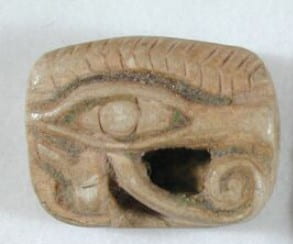Handling History with Sarah Dhanjal part 4
By Caroline Francis, on 12 August 2020
As part of a series looking at museum work that happens outside the public eye, we asked one of our longstanding workshop leaders about their experiences using different collections with primary school children. Sarah Dhanjal was an undergraduate and graduate student at UCL’s Institute of Archaeology and went on to a career working in engagement with many of London’s museums and collections. This blog talks about working with objects from Ancient Egypt and how she created a lesson in mummification.
The workshop I developed for UCL is for Key Stage 2 pupils, aged 8-11, and I visited many schools to run it over the course of nearly a decade. In recent years is has been delivered by an Egyptology PhD student, so there really is an expert behind the helm, something schools really want.
The Ancient Egypt session uses mummification as a focus. The topic really captures the imaginations of pupils so it is more likely than not included in school curricula. Maybe it seems a bit gory, the stuff of movies. There is an element of morbid fascination with societies seen as long dead and buried, there is something ‘other’ about it. I think it is an important point to start with though. How we frame a subject has a massive impact on whether the session will be booked or not. Popular subjects, like mummification, encourage schools to work with us and mean that we can provide academically supported content.
The previous resource we used to teach with included Ancient, Coptic and Modern Egyptian objects. The old session sought to explore themes like religion and writing across the three periods. Understanding the depth of time and the complexity of past societies interacting with each other is a challenge, especially those we tend to study individually. Making the session as simple as possible in terms of time period, place, and people was a priority.
I explored the needs of the objects both in the classroom and when travelling. One of the developments I made with the Institute of Archaeology collections manager was to ensure that the packing in the case also formed the protection for the objects in the classroom. It seems a relatively simple solution, but it had to be made specially by the conservators. Two bespoke pairs of handling trays fit together to make a box with plastazote packing inside, cut to fit two objects each. To ensure the objects were regularly monitored, given that the resources could be used by various people, they were signed for when leaving and returning to the museum.

Wedjat Eye, also known as the Eye of Horus is a symbol of protection, royal power, and good health. Petrie Museum Collection.
The session was designed to centre around four objects which link to mummification: a three finger amulet, a shabti, a heart scarab and a wedjat eye. Initially I designed the session to try to address as much as possible of the content I thought a teacher would need. I trialled an activity making a physical timeline with volunteers. I tried to get the children to come up with ideas for what the objects would do to help a mummified person get to the afterlife. I realised two things:
• Teachers are teaching core content like chronology already. It is useful for them to see someone else come in and elicit that knowledge from their class, or know that there are elements they need to revisit together.
• I was also reminded that Key Stage 2 pupils don’t have a wide range of experience of materials, objects or societies. So asking them to interpret Ancient Egyptian objects without more of a framework was too challenging.

Pupil examining a Shabti. Shabtis are small figures which were placed in tombs to magically perform heavy manual tasks on behalf of the deceased.
Now I don’t ignore chronology or content, it’s just taught with a lighter touch. I focus a lot more now on what the pupils can tell me, adding to their knowledge by linking with it. The introduction to the session is where this is most important, that lays out the context of the objects. So we discuss where Egypt is, what it is like, when we are talking about and what the Egyptians are famous for. You have to be prepared to be responsive to the pupils’ knowledge. I try to find out more about the subject areas I am teaching so I have interesting material to choose from. I’m also happy to say I don’t know something and offer to find out or suggest ways the class can.
I approached the object interpretation problem by giving a range of ‘jobs’ to choose from and asking the pupils to say what role the object filled and why. Justifying your interpretation is a useful skill to develop.

Sarah’s workshop activity provides a framework for KS2 students to examine and interpret the objects.
I don’t think I could describe an average classroom. They are all so different: the physical space; the atmosphere the teacher and the children create; the classroom dynamics when a visitor is in. I prefer to teach the class in their normal classroom with the minimum of movement of furniture so that it isn’t too different. Some classes are funny, others serious, some chatty. Teachers will often give you a steer: “they’ll push boundaries”; “they’re lively”; “they’re really lovely”. I could be strict if I need to, making it clear what I expect as a visitor. More often than not I could relax and inject some humour into the session. I do miss explaining that “scarab beetles are more interested in poo than you” (unlike the film The Mummy will have you believe)!
 Close
Close


